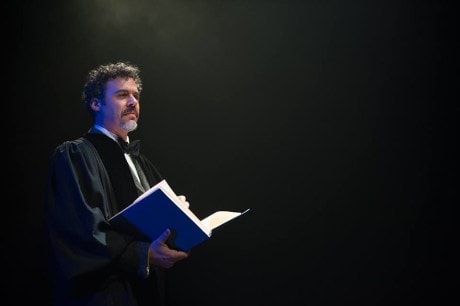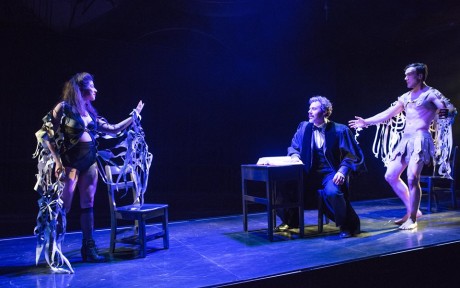One thing was abundantly clear as the youthful Quintessence Theatre Group cast took its curtain call to the cheers of a packed house: these players had fun. Fun you ask? Isn’t this The Tragical History of the Life and Death of Dr. Faustus, Christopher Marlowe’s 1594 tragedy of a man who sells his soul to the devil? Isn’t this about the eternal battle between the flesh and our greater natures? Or the place of good and evil in the universe?

It is all of that, and still a great deal of fun. Any director who attempts Faustus, (with its myriad spirits, sprites, emperors, clerics, visions, demons, even Lucifer himself,) must be part magician. Quintessence Artistic Director Alexander Burns, (assisted by a crack design team and a wonderful cast), pulls it off.
First the design team. Director/Set Designer Burns has used football staging with a thin 5-foot high platform slashing the Sedgwick Theatre down the middle. This raked black stage is full of surprises, including fluorescent footlights, unseen trap doors and a list of properties that would challenge any Shakespeare company. The prop masters in this case Curtis Coyote, Martina Plag, and Matt Hill deliver an array of thrones, winged angels, severed heads and confetti guns, as well as a group of delightful puppets. Faustus flies above the world on a real stage-filling dragon. It must be seen to be believed.
The costumes, by Jane Casanave, are an eclectic mix. Not mired in any one period, the raiments illuminate the characterizations skillfully. The stage is filled with popes, pre-WWI soldiers, apparitions and preppies. The slender but long stage hilariously becomes a couture runway at one point, with the seven deadly sins mimicking a high-class fashion show. One never knows how Mephistopheles, Faustus demonic servant/master, will appear. In one scene he is dressed as a medieval monk, the next as a Brandoesqe biker, then a coked-out yuppie, and then, Mack the Knife. The lack of a specific period adds to the enjoyment, as one never knows what will turn up next.
The lighting, smoke and strobe effects, courtesy of Brian Sidney Bembridge, contribute to the magical mood, while Director Burns’ inventive soundscape continually amazes as the strange cacophony skillfully punctuates the action.
Gregory Isaac leads the acting company in the title role. He is a professor whose desire for knowledge, as well as all the “fleshly pleasures” life has to offer, creates a deal with the devil. He begins casting his spells uncertainly, but once the bargain is sealed, he really enjoys himself. Twenty-four years of fun and games later, Mephistopheles comes to collect his due, and Isaacs truthfully evokes Faustus’ terror. He achieves all the elements of a complete tragic performance.
Josh Carpenter is a Mephistopheles who seems high on recreational drugs. Though he claims to be suffering the torments of the damned, he clearly relishes his journey with Faustus. They frequently embrace like frat buddies devising their next prank. These two performers’ oft-changing relationship skillfully anchors the evening, while the remaining company doubles and triples as an Alice in Wonderland band of weirdoes. Among these are Alan Brincks and Leigha Kate as “good” and “evil” angels, Ife Foy as an emperor who longs to meet the ancient heroes Alexander the Great and Darius, (Tom Carman and Brincks again), with John Basiulis as Lucifer himself, here cursed with senility.
Faustus alternates dramatic scenes with rather clumsily written low comedy, but Sean Close and Andrew Betz cleverly solve this problem. The amusing servants mimic Faustus’ desire to conjure spirits, but instead of desiring knowledge and fame, these clowns will settle for pornography.
Patrons who have seen the excellent Saint Joan, which runs in repertory with Faustus, will enjoy this troupe twice as much. The same eleven actors play in a totally different style, and each performer is allowed to demonstrate imagination and versatility. As in Saint Joan, the performers skillfully handle the difficult verse, making “Marlowe’s mighty line” sing out. What an impressive group! Anita Holland is seen as a tragic, pregnant duchess, while Aaron Kirkpatric is a soldier who awakens to discover antlers upon his head.
Director Burns manages some impressive staging moments as well. Aside from the aforementioned seven deadly sins, memorable compositions are Faustus’ battle with the good and evil angels, as well as his acrobatic love scene with Helen of Troy (Leigha Kato, who also plays St. Joan on other nights).
Add all of this into one magical cauldron and The Tragical History of the Life and Death of Dr. Faustus gets this critic’s highest recommendation. The troupe is still fundraising, (an envelope is enclosed with the program) but they have announced a summer production and in a few weeks will finalize their next season. Raves all around for this one.
Running Time: Two hours, with an intermission.

Dr. Faustus plays through April 24, 2016 in repertory with St. Joan at the Quintessence Theatre Company performing at The Sedgwick Theater – 7137 Germantown Avenue (Mount Airy), in Philadelphia, PA. For tickets call (215) 987-4450, or purchase them online.




